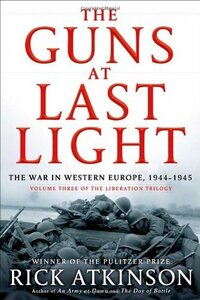Take a photo of a barcode or cover
The Guns at Last Light and its companion volumes in the Liberation Trilogy are a brilliant work of both scholarship and authorship. This history of the American involvement in the European Theater begins with the invasion of North Africa, and ends with the surrender of Germany. In between are countless stories of the battles, the individuals, and the strategy and tactics of the Allies in pushing back and eventually destroying the western portion of the German war machine. Atkinson deftly moves from anecdotes about individual leaders, soldiers, and (a few) journalists to accounts of the battles that always emphasize the experiences of soldiers in the battle field -- and still manage to convey the larger movements, tactics, and strategy.
That's a bold scope, and one requiring a keen grasp of events at scales ranging from the individual to the continental. Atkinson's judicious choice of maps (available on the web) provide an excellent supporting context to the text. In anecdotes and quotes he weaves a picture of some of the key players in the joint Anglo-American effort (and the French bit players, always trying to remain relevant). His treatment of most of the players is remarkably nuanced, allowing the reader to see men like Eisenhower, Alanbrooke, Churchill, Patton, Bradley, and Montgomery in terms of both the qualities that enabled them to rise to the challenges they faced, and their foibles that remind us of their very fallible humanity.Perhaps the best indication of how good this book and its companion volumes are is the degree to which it sparks interest in topics both within and outside its scope. Atkinson's brief and wrenching description of the capture of concentration camps and the horrors seen by individual soldiers, his brief references to the Eastern Front and the titanic struggle there, and references to the massive production effort in the US to supply both the European and Pacific theatres all impel me to read more about this particular era. For it remains relevant to us here, today. As Atkinson notes the particular fascination and power that Hitler held over both his military and his country, one cannot help but reflect on the currently ascendant authoritarianism within a faction in this country that despoiled our Capitol on 1/6/2021, and currently seeks to control who votes in our elections and to place them under the control of overwhelmingly white GOP-run state legislatures, even explicitly given partisans the opportunity to overturn election results. In that context, histories such as this one have lessons to teach, if we will but listen.
There are two things that standout about this book: good use of maps and the use of anecdotes. I tend to think of the books in this series to be Edu-tainment instead of histories. If I take exception, its that the analysis could be deeper. I also think the photographs chosen could have been better.
Use of maps is the best I've seen in any military history. They are a modern, graphics design spin on the best of breed visualization from more traditional texts. All modern histories should have maps of this quality.
Atkinson is a journalist with literary pretensions first, and a historian second. His histories are stories. His descriptions are evocative. This is a talent most military historians do not have. In addition, he peppers his narrative of events with short anecdotes on people, places and historical events. The added context is sometimes amusing. (Churchill's imbibition of alcohol comes to mind.) Many times its informative.
For example, I liked the geographical comparison between Napoleon's return from Elba and the 100 Days with the progress of Operation Dragoon.
The analysis of important command decisions and the results of circumstance is brief. I suspect I miss any what if discussion because this book has a story-like narrative.
For example, the implications of not forcing the Belfort Gap which would have uncovered the Saar region and affected the September/October 1944 Allied drive on the Ruhr.
This is also very much an Allied, chiefly American history. The preponderance of anecdotes, and excerpts from correspondence, diaries, and biographies are American. It would have been an interesting counterpoint to include a reminiscence of Cpl. Franz Bauer of Panzer Lehr's on the retreat to the Rhine, to compare with Sgt. Joe Farmer of the 101st Airborne.
This is a worthy read for those interested in the American history of WWII in Europe. In particular, because not since [a:Cornelius Ryan|48305|Cornelius Ryan|https://images.gr-assets.com/authors/1332088952p2/48305.jpg] has there been an author writing easily readable books on the subject. I'm sad to see the series end.
This is a really good final book of the trilogy. From North Africa until it's finish in Germany, the writing takes you up and into the lives of those who won the war in Europe for the U.S.
There are shelves, even rooms full of books on WWII. If you must limit yourself to one piece of work on the war in Western Europe, this trilogy might be the one. The drawback would be that it is essentially told from the Allies point of view. This is, as the title suggests, a "Liberation" trilogy, not a "War" trilogy. But the exhaustive research, superb organization, and mostly fluid writing is remarkable.
Few writers can bring the enormity of these events to life, but Atkinson tells the big-picture story, while interweaving stories of individuals all across the command structure.
If your historical interests lean toward WWII, this trilogy is a must-read.



